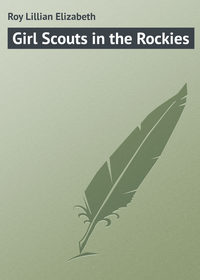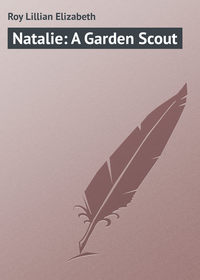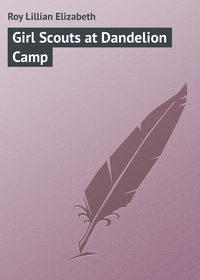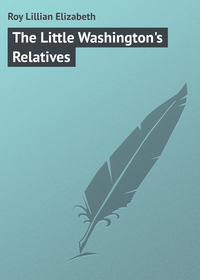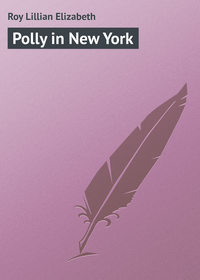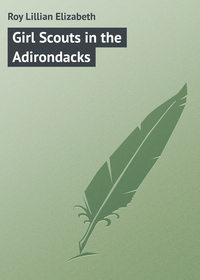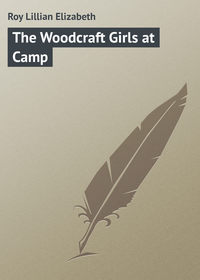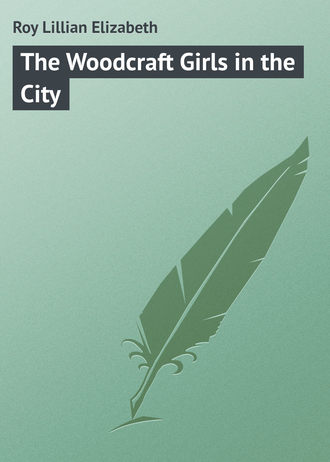 полная версия
полная версияThe Woodcraft Girls in the City
The entire area along the Palisades had been purchased as city property and was being ploughed over; diseased timber was cut down, and down timber chopped up ready to remove, when the Tribe first caught a glimpse of the place. Wherever a clearing had been, was now used for piling up refuse, stones, and brushwood. The day was unusually warm for the season and the heavy packs which had to be carried to camp did not help anyone to feel more cheerful.
“Oh, this is awful! I wish I had never come!” complained Eleanor, stopping every other moment to gasp and rest.
“It isn’t very alluring, I must admit,” said Miss Miller, as disappointed as the others.
“Great Caesar’s ghost! What are they going to do with this upside-down area!” finally cried Nita, as she caught her toe in some half-buried trash and fell head-long into a rut newly ploughed that week.
“It’s in the throes of being transformed into a Park!” laughed Zan.
“Oh no!” called Jane, “this is the evolution of a dancing floor for Nita.”
After many stumblings and grumblings, the Tribe reached the cool shadows of the woodland where they found a plain trail running along the crest of the river bank. Zan led the way and after they had gone some distance through the dense woods she came to a natural clearing that projected far over on the cliff. She went out there and instantly dropped her pack.
“Oh! Come here and see the wonderful view!” shouted she.
Everyone dropped the tiresome luggage and gladly ran out to join Zan.
“Ah! This repays us for all the toil and hardships endured,” exclaimed Miss Miller, with clasped hands, admiring the view.
From the point where they stood, hundreds of feet above the majestic Hudson, they could see up and down the river for miles. The city of Yonkers was opposite, and the river-craft plying the Hudson provided interesting scenes to the girls. The gorgeous colouring of foliage on both sides of the river clothed the hills and cliffs with beautiful tones made by Nature’s paint-brush. The air was sweet and warm, and crickets, some late birds, and insects added their voices to the general music of the Falling Leaf Moon.
“I wish we could camp near here,” ventured Jane.
“I thought I heard running water before you joined me. Maybe we can find a brook or spring,” suggested Zan.
“I heard there was a beautiful bit of water here called Alpine Falls. If we could only find it!” said Miss Miller.
“Let’s separate and scout for it. Leave the baggage here for the time,” responded Zan.
But they had not far to search, for Zan had heard falling water, part way down the steep Palisades, falling from a great height on a rocky peak to a glen beneath. The stream that fed the falls had worn a narrow but deep gully on top of the cliffs, and Miss Miller was the one to discover it as she sought for a good camp-site. A rustic bridge spanned the ravine and a path led a circuitous way down to the ledge where the Falls formed a foamy pool before running over its rocky basin to tumble recklessly on down to join the river.
Miss Miller wished to assure herself that it would be a safe spot for so many girls to camp, so she followed the path to the ledge and there saw a rustic sign nailed to a tree, “Alpine Falls – no camping allowed on this ledge.”
She climbed back again and called to the Tribe to join her. They were delighted with the place, and when Miss Miller told them of the sign they agreed to camp at the clearing on the point and use the Falls for cooking and wash water.
“I hope to goodness no one here is a sleep-walker,” laughed Zan, waving a hand in the direction of the precipice.
“No one here guilty of that habit!” replied Miss Miller.
So camp was pitched and preparations for supper well under way before Jane said: “We forgot to think of a swim.”
“Too late! Besides, we’ll have to crawl down this wall and see if there is any sort of a place where we can get in,” answered Zan.
That evening they enjoyed riddles, charades, and Nita danced a wild flower dance she had invented. Miss Miller told them of some of her interesting experiences while travelling in Egypt and the Old World, and then to bed.
Early in the morning, Zan turned over in her tiny cot and yawned. Awake in an instant, she sat up and sniffed.
“Who’s baking breakfast gems? They smell fine!”
She jumped up and peeped from the flap of the tent. At a good camp-fire she saw the funniest baker she ever thought possible to utilise. But no one was about, so she crept out in her pajamas and grass slippers to investigate.
On a smooth stick safely driven into the ground near enough to the camp-fire to warrant a steady heat reaching it, was twisted a long flat strip of dough. It began to wind about the stick from the bottom and ended near the top. As it baked and browned on the side nearest the fire, a delightful aroma came from it and permeated the air.
“Well, I never! If this isn’t the most ingenious device!” murmured Zan, chuckling to herself.
“Watching my bread-twist, Zan?” called a voice, and Zan looked over to see the Guide coming from the Falls where she had had a cold bath.
“Yes, but I was wondering how to give the offside a chance to brown?” replied Zan.
“I’ll show you – simple as anything.” And Miss Miller merely took hold of the top-end of the stick and gave it a sharp turn. Naturally the bread turned with it, and the side that was brown was now facing away from the fire while the other side was turned toward it to bake and brown.
Zan laughed and nodded her head approvingly, then glanced at the other breakfast food cooking. Cereal was boiling in a pot hanging over the fire where the bread was baking, and apples were stewing in a saucepan.
“Did we bring apples yesterday?” asked she.
“No, but I found a little old tree down the trail and most of these were picked up from the ground. Don’t they smell good?”
“Um-m! Should say they did. But tell me, Miss Miller – did you stay up all night to work like this?”
“Hardly! I got up an hour ago and mixed the bread dough, then started the fire. After that I wanted to see what kind of a country was back there, and I found the apples. When they were stewing and the cereal on boiling, I went for my morning wash.”
“I’ll run in and wash and dress, then I’ll be back to help,” said Zan, starting off for the tent.
Hilda was already up and dressing when Zan ran in, and both girls chattered so noisily about the bread-twist that the others awoke and jumped out of bed.
When Zan and Hilda returned to the camp-fire the Guide asked Hilda to broil the ham while Zan spread the breakfast cloth.
“What can I do?” asked Jane, coming over.
“You can get a pail of fresh water from the Falls and fill the cups at each plate,” returned the Guide.
That breakfast was appreciated thoroughly by everyone, for the bread was hot and crisp and the ham fried as brown as any ever served by Southern cook.
“After we finish breakfast and have cleared away the dishes, we must explore the immediate neighbourhood to find out if we are on a main trail where visitors are liable to come and interrupt our peace,” said Miss Miller.
The camp chores done, the Tribe started for a hike, intending to circle their camp-site and look for possible intruders. They had followed the trail but a short distance before Miss Miller spied some fine white birches. Some of these had been cut down as being in the way for the proposed roadways of the park. The Guide immediately found a use for the large sheets of bark that were peeling from the trunks.
“Girls, we will postpone our scouting for a time when there is no important work at hand, but now do let us collect as much of this splendid birch bark while it is offered us without damaging standing trees.”
The Guide then showed the eager Woodcrafters how to peel the bark to keep it in large sections and not split it into strips. When everyone was laden with as much bark as could possibly be carried, they started for camp and deposited their freight on the ground.
“You need not waste a bit of this bark – even this bit will make the outside of a dainty pen-wiper. It can be cut oblong and decorated with gold-paint. With leaves of felt or flannel between the two sections, and these tied together with a cord or ribbon, it makes a pretty memento.”
“I suppose Miss Miller will find endless ways to use this tinder, just as she did for the sea-shore pebbles and shells,” remarked May, laughingly.
“I can think of enough ideas right now to keep you girls busy until Christmas,” rejoined the Guide, also laughingly.
“For instance?” questioned Zan, curious to hear the items.
“Well, you can make needle-cases, pin-cushions, boxes for neckties for the boys, boxes for handkerchiefs for parents, picture frames, veneering for rustic furniture, Tally Book covers, camp utensils – such as dishes, pots, pans, and platters, toilet sets, and many other things.”
“That’s right! I never thought of using birch bark for such things,” declared Elena.
“Make a record of it in the Tally!” teased Zan, for Elena was acquiring the habit of entering everything in that book.
“If we should find any sweet grass on our walks while here, we must be sure and gather it, as it is what is needed to sew up the seams of birch bark. If the grass is wound about with red linen thread it makes it much stronger and looks pretty, too. The bark must be punched with a row of holes so the grass-binding can pass through without tearing. I think we have a punch at home such as children use in a kindergarten school.”
“Miss Miller, do you know of other articles to make out of wild-wood things?” asked May, with awe at the Guide’s knowledge.
“Well, I think pine cones make the oddest and prettiest things. The small cones combined with birch bark are lovely. I have made frames by glueing cones in patterns on thin bark-covered wooden frames. I have a large picture of George Washington at home that I framed in this way years ago. Then, too, I will show you a work-box that I made for my mother. It was made of a cigar-box and covered with bark. On top of the lid, and about the sides, I glued different kinds of cones and stems. Then I varnished the whole thing and it was beautiful, in my estimation. It has lasted to this day, and I made it over five years ago.”
“I waxed some Autumn leaves last year and we used them over the windows and doors until Christmas time. Everyone said they looked so pretty,” said Elena.
“Why can’t we gather some of these beautiful leaves and do the same thing with them, Miss Miller?” asked Jane, eagerly.
“We must wax them with sperm and iron them as soon as they are cut from the branches. You see, the colours remain exactly the same as when they were gathered if you wax them before they have time to dry. Whole branches can be waxed this way and used for decorative purposes. Florists to-day use great masses of waxed Autumn leaves in their exhibits, or for back-grounds through the Winter months. But care must be taken when ironing the spermaceti over the leaves that the hot iron does not touch the stem or wood of the branch. If it does, the leaf will immediately fall off.”
So much time had been taken by the collecting and descriptions of articles made of birch bark, that it was noon before anyone dreamed it was more than ten o’clock.
“Girls, we ought to find a place for a swim and then have lunch. After that we will seek for a neighbour – if there are any on this crest,” said Miss Miller.
But the girls could find no way to get down the steep cliff-side unless they went a long way back. So they gave up the hope of a swim that day and started off to seek for adventure.
They had gone about a mile in a new direction when one of the girls glimpsed a fine old mansion painted so nearly like the green and russet colouring of the woods that it was difficult to distinguish it from its beautiful setting.
“No wonder we didn’t see it before,” remarked Zan, gazing at its dark brown shingled sides and green roof.
“It doesn’t seem occupied. Maybe the people do not live here,” suggested Elena.
“There’s a rustic fence with a gate. I can see a notice hanging on the gate – let’s see what it says,” called Jane, who was in advance of the others.
In a few moments the Band stood reading the sign. “No trespassing on these grounds under penalty of the law.”
“We’re not on their land yet, but it’s a shame to have a fence cut off an adventure right in the middle of a trail!” pouted Nita.
“It may prove a far more thrilling adventure to sit here and try to explain the reason for closed shutters and an abandoned house at this time of year,” ventured Miss Miller.
Even as she spoke, a gardener came forward along a side path, and doffed his cap.
“I heared your voices an’ I sure was s’prised to find a lot of school-girls. You – all seldom come as far as this. The ‘Annabell’ – that’s the launch runnin’ from Yonkers to Alpine and back agin – generally leaves ’em at the foot of the cliff where they picnic.”
“We saw the sign and wondered if we were trespassing out here?” replied Miss Miller, in a questioning voice.
“Not at all! In fack, it would be all right for ladies to walk through the groun’s when no one’s home. The family’s gone for the season now. We have to keep the sign up, just the same, to keep out the roughs from the city who would destroy the trees and flowers fer nothin’. Would you like to come in?” asked the old man, politely.
“I think not, thank you. We are camping down on the point by the Falls, and this was an afternoon hike. Now we will go back and hunt for a spot where we can bathe,” explained the Guide. “I kin help you there. I haven’t gone down to take up the two boats yet, or remove the portable bath-house we have on the beach, an’ you’se are welcome to use both boats and house if it will accommodate you.”
“Oh how lovely!” cried the girls, before Miss Miller could decide what would be the proper thing to do. So she smiled and thanked the generous stranger.
“I’ll jes’ run and git the keys to unlock the padlocks and bring you’se the oars.” So saying, the old man hurried to the barn back of the mansion.
“Now isn’t this a real adventure?” laughed Miss Miller.
“And we wouldn’t have had it if there wasn’t a house and a care-taker here to obstruct the trail!” added Zan.
It didn’t take the Woodcrafters very long to run back to camp and find their bathing togs, then on down the steep path that seemed to drop sheer from the heights to the river-beach.
The two boats added greatly to the fun of the water-sports. As every girl could swim a little, and the water was shallow near the shore, there was no danger in toppling out of the boat.
There were some glorious battles of “tag” played with a bag of old cork found on the beach. One girl would throw the bag and, if it landed in the other boat, that side was “it” and was supposed to chase the opponent and try to fling the cork into their boat.
When they began to weary of this game, the Guide announced a swimming contest. Then followed a diving contest. Lastly a prize was offered to the girl who could swim under water and bring up from the river bottom the white flour-bag filled with sand which Miss Miller had prepared and was ready to drop from a boat into the clear depths of the river.
The spot designated was about ten feet deep and about ten yards from shore, but only a few girls could swim under water and it transpired that only Elizabeth Remington could swim with her eyes open. Naturally she was the one to bring up the trophy.
“No wonder we couldn’t do it when we never tried to keep our eyes open under water – it hurts!” grumbled Zan, who disliked to be outdone by another girl.
Miss Miller silently exulted in the success of her little plan, for she knew Elizabeth could accomplish the deed and wanted the other girls to see her do it, thus imbuing them with the desire to try also.
“Maybe it hurts at first, but I’m going to get that bag!” declared Jane, plunging in and trying to open her eyes while swimming under the water.
Others dared the test also, and soon all were sputtering or laughing at their trials and failures. Finally, however, each one could brag of being able to keep eyes open if but for a few seconds while swimming under water.
As they climbed the cliff again, Miss Miller said: “I think it is as important to know how to swim under water with your eyes open to see what you are meeting, as it is to keep your eyes open when crossing a thoroughfare.”
“Ha! Discovered in the act!” laughed Zan, pointing an accusing finger at the Guide.
Miss Miller laughed also and nodded.
“What?” questioned May.
“She did that stunt on purpose to make us keen to learn the trick,” hastily explained Jane, who saw the nod and guessed rightly.
That evening while sitting about the camp-fire Miss Miller suggested a Hallow E’en treat for Zan’s birthday. She spoke of many ways Woodcrafters could celebrate, providing the weather was fair for a weekend camp in the woods.
Then Elena made a suggestion. “I am going to design and make a Woodcraft article to give our Chief for a birthday gift.”
“I think that’s great! I’ll do one, too,” added Jane.
“So will I,” echoed Hilda.
“Let’s all make something in Woodcraft for the party,” said Nita.
“Girls, why not exchange gifts with each other and make them ourselves in Woodcraft style? We need not limit the giving to Zan, you know,” suggested the Guide.
“Gracious me! It will take a pile of presents and ages to finish them all,” exclaimed Eleanor Wilbur; “I can’t do it.”
“I had no idea of elaborate gifts. For instance, Nita can dance a new step on the evening of the party, and teach it to Zan for a present. That will not take her long nor be much work,” explained Miss Miller.
“Oh, that won’t be a gift!” laughed Nita.
“Why not? Won’t it be the expression of your desire to give pleasure to another? And won’t Zan remember your love and generosity that really constitutestrue giving? It is a mistake to look at the material object as the gift, and forget the loving spirit that formed the thought which expressed itself in the thing. The material gift is destructible, but the love of a friend remains forever the true gift.”
“According to Miss Miller, then, we will be silly to waste time on producing material objects when we can easily wish our love on anyone,” retorted Eleanor, in an unpleasant tone.
“Eleanor, when we reach that state of perfect brotherhood of which Jesus spoke as Heaven, we shall exchange love and goodness without the material accompaniment, but while still on earth our limited vision and other senses require the expression in kind as we are, to be able to realise the love and desire to make others happy. That is why we are compelled to plan and work before our friends know the state of our feelings. For instance, your words spoken in tones and expression of human resentment show me quite plainly that your thought is wrong – that you rebel in mind against doing what was proposed by the love of the other girls. But I may not have realised this state of your thought had you not expressed it – see what I mean?” said Miss Miller, meaningly.
Eleanor flushed but said nothing. And Zan quickly said: “Say, girls, we can all win coups that will count if we make some Woodcraft things mentioned in the Manual!”
“So we can! And each can choose what she likes,” abetted Jane.
CHAPTER TWELVE – A BIRTHDAY COUNCIL ON HALLOW E’EN
In the days following the camp-talk, the girls saw little of each other after school, as they were busy working on the gifts to be distributed at the Hallow E’en camp.
Zan had spoken of a pattern Nita had for a dancing costume, so Nita made the dress of cotton crepe, costing very little in coin of the realm but much in thought and work. She disliked sewing and the very fact that she spent so much time to have the costume neatly finished spoke highly for her progress in character as well as of her way of expressing friendship.
For the other girls, Nita wrote out simple directions to dance improvised steps of old dances. She also printed simple music fitted to go with the unique steps.
For Miss Miller, she made an artistic programme for the Gift Ceremony which was explained to her by Mrs. Remington. This was to be used on the occasion of the birthday evening.
Hilda naturally followed the line of least resistance in selecting her gifts. She made candy, baked a cake, wrote out a tiny Tally Book of recipes for the Guide, and having packed the candies in empty boxes she always saved for the purpose, she did each package up in yellow crêpe paper and tied it with black cord; on the knot tied on top of the boxes she fastened a black cardboard bat or a witch with a broom-stick.
Elena, adept with the brush, made individual Tally Books of brown butcher paper and bound them in leather with thong strips to fasten them together. She had secured the small remnants of tanned leather at a wholesale leather house in the factory-district of the city. The Tallies were decorated with the name of the individual artistically printed in India ink, and the scroll decorations were so wrought that black cats, witches, pumpkins, broom-sticks, bats, and other suggestive things of Hallow E’en were featured as a remembrance of the party.
Jane made a dozen narrow beaded head-bands which showed in the designs the meaning of Hallow E’en. They were very beautiful and were sure to be appreciated by the girls. Besides those for each member of the Band she made one for Elizabeth Remington, who was invited to the party, and one for Miss Miller.
Zan made the unique decorations for the party. Each was wrapped in paper and the name of the girl printed in plain view. These gifts were original and diversified in style.
She took empty cereal boxes – square ones as well as the round cartons used by Quaker Oats – and cut designs in the sides, having sketched the pattern on the cardboard before cutting away. A metal clip as is generally used on Christmas trees to hold the candles was inserted in the bottom of the box and fastened to hold a candle when necessary. Picture wire was fastened at the top to suspend the box. When this was finished, she blackened the entire box with cheap shoe-polish to represent wrought iron.
Zan also found two Edam cheese cases about to be thrown away and these she captured for use. The contents had all been scraped out, so she cut a hole in the bottom of the rind for a candle socket, then cut grotesque mouth, nose, and eyes in the sides. Wire was used at the top to hang them by and when finished they looked very funny. These Zan meant for Miss Miller as a joke.
Her next idea was to collect a number of empty tin cans and melt off the jagged rims left when the covers had been cut out. A few perforations were made in the bottoms for drainage, and the sides painted an ivory white with black stencilled designs on them. Some of these were Egyptian figures copied from ancient friezes shown in a book. When these cans were filled with soil and a plant inserted, the effect was very artistic and at little expense.
May Randall, who had won the prize for carpentry, made small boxes with leather hinges and brass-studded corners. She burnt designs on covers and sides and touched up points here and there with red or blue paint, then varnished the whole surfaces. These were meant for wampum, badges, or other Woodcraft trinkets.
Another new member selected pottery for her gifts. She made original designs and when these were finished and touched up with black paint and bright colours they were very artistic.
Another girl made fire-boards. She used the oval bread-boards sold for five cents each in the five and ten cent stores. The ovals were sawed in the centre, giving two sections for each. Four half-ovals were hinged to a square board so they would fold down when not in use. The rounded sides were then decorated with symbols of the Winds and Fire. When varnished and completed, they proved very fine and useful.
Frances used the birch bark she had saved from the Alpine camp. Trays, jewel-boxes, waste-baskets, picture frames, work-boxes, and other ideas were carried out. The birch bark was soaked in hot water until soft, then shaped as desired. The lacing of edges was made of raffia also softened in water. Where strong lacing was necessary several strands of raffia or grass were braided together and used. The sides of the ornaments made were decorated in sepia paint, representing forest scenes or Woodcraft designs.


